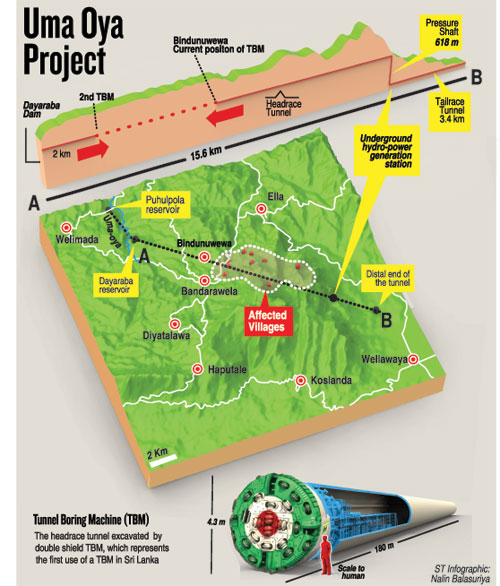News
Uma Oya: The plight at the end of the tunnel
View(s):Houses collapse, walls crack, wells dry up, village economy suffers: People seek answers as a controversial irrigation project continues regardless
As affected residents rose as a force on Wednesday to shake the hills to draw the Government’s attention to the serious problem they have been grappling with for months without hope, the Sunday Times journalists Anthony David and Kasun Warakapitya accompanied by photojournalist Indika Handuwala undertake a study tour of the affected Bandarawela and Ella areas for an on-the-spot report
Bandarawela, known for its salubrious climate and perhaps the largest hill country town to draw domestic tourists after Nuwara Eliya, may soon lose its lustre. Walls in houses in vast areas surrounding the town are cracking, wells are running dry, paddy fields have turned barren and living is becoming hell for the residents. The worsening tragedy is playing out in at least six AGA (Assistant Government Agent) divisions spreading from Bandarawela to Badulla.
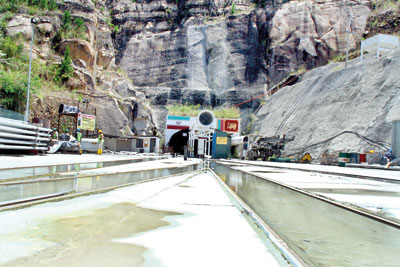
Water gushing out from the tunnel is sent through two drains at the end of the tunnel at Karandagolla
Drinking water is supplied to residents’ tanks aptly named ‘Uma tanks’. To some residents, pipe-borne water is made available once in 10 days. All because of a 20 km tunnel which is part of the previous government’s ambitious Uma Oya project.
The initial estimated cost of the project was US$ 529 million, but is expected to be higher. The project was to be funded through a US$ 450 million loan from the Iranian government, but in view of US sanctions on Iran the funding is due to come in from the Sri Lankan government.
Just last Wednesday, we saw an estimated 7,500 villagers crowd the Bandarawela town for a protest to demand that their woes be heard by the Government. They blocked the Podimenike train for over two hours, preventing it from leaving the Bandarawela station to Badulla.
Shops and business establishments remained closed and roads were blocked while the government offices operated with skeletal staff. Attendance in schools dropped and courts adjourned earlier than schedule. Black flags were put up on lamp posts as protesters, some wearing black bands, entered the town from three different directions to hold a protest rally. Several speakers, including Buddhist monks, addressed the gathering from a make-shift platform set up near the Bandarawela main bus stand. Motorists were forced to take alternative routes, because they could not gain access to the main Colombo, Badulla and Welimada roads.
The protests were called off only after they got an assurance from the President’s office, shortly before dusk. They were told President Maithripala Sirisena would meet a delegation on Friday.
Under the Uma Oya project, a dam has been built at Puhulpola in Welimada to divert the water — through a 3.9 kilometre underground link-tunnel — to the Mahatotilla Oya in Dayraba where another dam is under construction. The water is then diverted across a 15.6 km underground tunnel to the proposed power station at Karandagolla, off the Ella-Wellawaya Road.
Generating hydropower and providing drinking water, and water for irrigation and industries are the main objectives of the project. The dry zone areas of Wellawaya and Hambantota are to be irrigated by the diverted Uma Oya water.
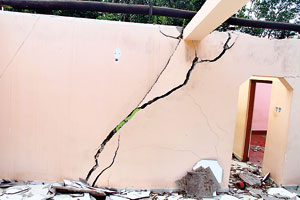
Common sight: Whereever we went, we saw cracks on the wall and damaged houses

Farhana's house: The local council has asked the residents to move out before it crumbles
During our visit to one end of the tunnel at Karandagolla, we saw a large volume of water seeping through a leak. Deputy Minister Anuradha Jayaratna recently told parliament that every second around 1,070 litres of water escape through the leak. But site official told us that it had been reduced to around 850 litres per second now.
“The objectives may be good, but it seems the authorities are not concerned about the residents and their welfare,” says Gunapala Edirisooriya, a resident at Thanthiriya in Bandarawela. Pointing at the walls of his house, he said they stood like a monolith for more than 50 years, now we see cracks all over. “I am old. I can’t start building a new house,” Mr Edirisooriya said, taking us to show his gate’s twisted metal railing and the cracks on the retaining wall.
His is not the only house with cracks. There are many. The cracks in an upstair house are so noticeable that we can see them from the gate at the top of the garden path. We also saw the warped floor with the floor tiles being dislodged. Fathima Farhana, who lives in this house said the Bandarawela Municipal Council had advised them to move out. “But where can we go. Where is the money to buy or build a new house. The authorities do not give answers to our questions,” she said.
Hapless residents say officials would visit them only months after complaints are made regarding the cracks. Even then, they will only mark the cracks and go off, never to come back, they charge. Thilak Abeysinghe, a resident of Arawatte in Udaperuwa, a village some three kilometres from the Bandarawela town, says some of the houses have already collapsed, rendering the occupants homeless. ‘My neighibour’s house collapsed, three months after the cracks appeared,” Mr Abeysinghe said pointing at the heap of rubble that was once a house.
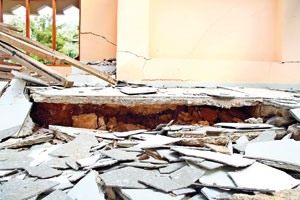 M.D. Lankathilaka, another Udaperuwa resident, complained that his well had run dry. This had never happened before, he claimed.
M.D. Lankathilaka, another Udaperuwa resident, complained that his well had run dry. This had never happened before, he claimed.
“Just put your self into a situation where you have been living in an environment with plenty of water, and suddenly the water is rationed and you are supposed to adjust your lifestyle,” he said.
The authorities provide water to some areas. Pipe-borne water is restricted to once in 10 days. An angry housewife Ranjani Perera asked, “Do they expect us to fill up the tanks and wash all the clothes in just one day?” Officials concede that the area is facing an acute water problem. Bandarawela Divisional Secretary Nihal Gunarathna said they were unable to meet the villagers’ water demand.
“Thirty six browsers have been deployed by a company involved in the project to distribute water. It works in coordination with the Divisional Secretariat. The daily water requirement is 550,000 litres, but they are unable to meet the requirement,” he said. The Divisional Secretary said they even send bowsers to distant areas in search of water.
Also affected by the water crisis are business establishments in the Ella area, a popular tourist destination. Hoteliers and businessmen have been exploring ways and means to find water, but with little success. Ella Tourist and Trade Association Chairman Sunil Premasiri told the Sunday Times than 5000 people who made a living out of the tourist industry would be affected if an early solution was not found.
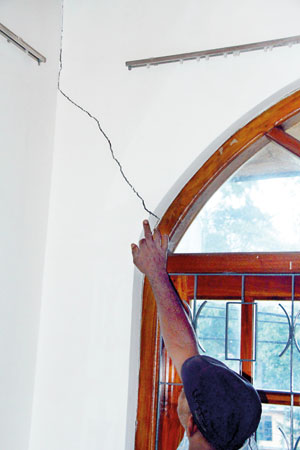 He said tourists would be hesitant to check in at Bandarawela hotels because of the risks involved,” he said. “Agriculture and farming in the area have also been affected and business is down. The crisis has hit the people’s income,” Mr. Premasiri said. Sushan Fernando, a hotel manager in Ella, said they hired bowsers or private vehicles to bring water from distant places.
He said tourists would be hesitant to check in at Bandarawela hotels because of the risks involved,” he said. “Agriculture and farming in the area have also been affected and business is down. The crisis has hit the people’s income,” Mr. Premasiri said. Sushan Fernando, a hotel manager in Ella, said they hired bowsers or private vehicles to bring water from distant places.
In every affected village or area we visited, we could see the anguish of desperate residents. Uncertain about their future, they blame the Government for not paying much attention to a serious crisis. The Ven. Kurukudegama Jinananda Thera of the Shri Sudharshanaramaya in Kurukudegama is the joint president of an organisation calling itself “Uma Oya Bahu Winashakari Viyapurthiyata Erehi Janatha Peramuna” (The People’s Front Against the Multi-destructive Uma Oya Project). He said the villagers’ complaints had gone unanswered for months and it was time that they took some action to attract the Government’s attention to their plight.
“We understand the project cannot be reversed, with almost 80 percent of it being completed. But what we demand from the Government is that it should take immediate steps to get down experts to correct the situation and provide relief to the affected people.”
The Thera said they were to meet the President and their struggle was not political. “It is the people who are now coming forward . The government should pay attention to this.”
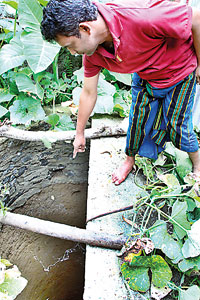

Never happened before: An Udaperuwa resident points to his waterless well
| Project company promises new houses, seeks international expertise to stop leak Pashoutan Dezfoul is the Project Manager of FARAB, the Iranian company which has undertaken the Uma Oya Multipurpose Development Project. He says those who lost their houses will be provided new houses. 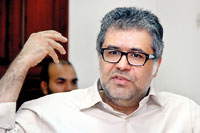 Pashoutan Dezfoul: International help being sought “We will provide houses to those whose houses were damaged due to the project. We are working closely with the Government to do our best to protect the houses,” he says. He says the company is also working closely with authorities in providing water to the affected people by sending them bowsers and giving them water tanks. Mr. Dezfoul says expert advice had been sought to close the leaks and continue with the project. Describing the water seepage into the tunnel as unforeseen, he says they are taking measures to solve the problem. “We are proceeding with the tunneling while carrying out studies to understand the situation better from a geotechnical engineering perspective. “We are seeking expert advice on how to improve the Tunnel Boring Machine (TBM) and grouting.” He says that one way of controlling the situation is to expedite the tunneling process by sending two TBMs from both sides of the underground tunnel, instead of one. “To address the water ingress (leakage) issues, we are consulting experts from Switzerland, Iran other countries,” he says. “We have completed more than 82 percent of the work. We also should explain to the people the benefit of the project.” | |
